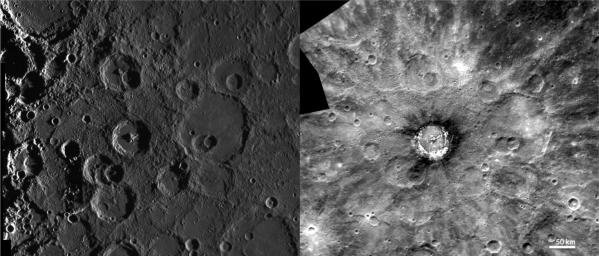
|
An Optical Illusion
- Click the image above for a larger view
- Full-Res JPEG (1652 x 706) (231.5 kB)
- Full-Res TIFF (1652 x 706) (1.2 MB)
Caption:
This side-by-side comparison of Basho crater under two different illumination conditions illustrates the importance of MESSENGER's various imaging campaigns. Although the image on the left reveals more about Mercury's surface morphology through exaggerated shadows due to a high solar incidence angle, it fails to display the interesting dark material surrounding the crater's rim or the extensive system of bright rays that become obvious in the image to the right.
The image on the right was acquired as part of MDIS's high-resolution albedo base map. The best images for discerning variations in albedo, or brightness, on the surface are acquired when the Sun is overhead, so these images typically are taken with low incidence angles. The albedo base map is a major mapping campaign in MESSENGER's extended mission and will cover Mercury's surface at an average resolution of 200 meters/pixel.
The image on the left was acquired as part of MDIS's high-incidence-angle base map. The high-incidence-angle base map is a major mapping activity in MESSENGER's extended mission and complements the surface morphology base map of MESSENGER's primary mission that was acquired under generally more moderate incidence angles. High incidence angles, achieved when the Sun is near the horizon, result in long shadows that accentuate the small-scale topography of geologic features. The high-incidence-angle base map is being acquired with an average resolution of 200 meters/pixel.
Instrument:
Mercury Dual Imaging System (MDIS)
Center Latitude:
-32°
Center Longitude:
190° E
Resolution:
200 meters/pixel
Scale:
Basho crater has a diameter of 74.6 km (46 miles).
Background Info:
The MESSENGER spacecraft is the first ever to orbit the planet Mercury, and the spacecraft's seven scientific instruments and radio science investigation are unraveling the history and evolution of the Solar System's innermost planet. Visit the Why Mercury? section of this website to learn more about the key science questions that the MESSENGER mission is addressing. During the one-year primary mission, MDIS acquired 88,746 images and extensive other data sets. MESSENGER is now in a year-long extended mission, during which plans call for the acquisition of more than 80,000 additional images to support MESSENGER's science goals.
These images are from MESSENGER, a NASA Discovery mission to conduct the first orbital study of the innermost planet, Mercury. For information regarding the use of images, see the MESSENGER image use policy .
Cataloging Keywords:
| Name | Value | Additional Values |
|---|---|---|
| Target | Mercury | |
| System | ||
| Target Type | Planet | |
| Mission | MESSENGER | |
| Instrument Host | MESSENGER | |
| Host Type | Orbiter | |
| Instrument | Mercury Dual Imaging System (MDIS) | |
| Detector | ||
| Extra Keywords | Crater, Grayscale, Map, Radio, Shadow | |
| Acquisition Date | ||
| Release Date | 2012-06-22 | |
| Date in Caption | ||
| Image Credit | NASA/Johns Hopkins University Applied Physics Laboratory/Carnegie Institution of Washington | |
| Source | photojournal.jpl.nasa.gov/catalog/PIA16343 | |
| Identifier | PIA16343 | |
